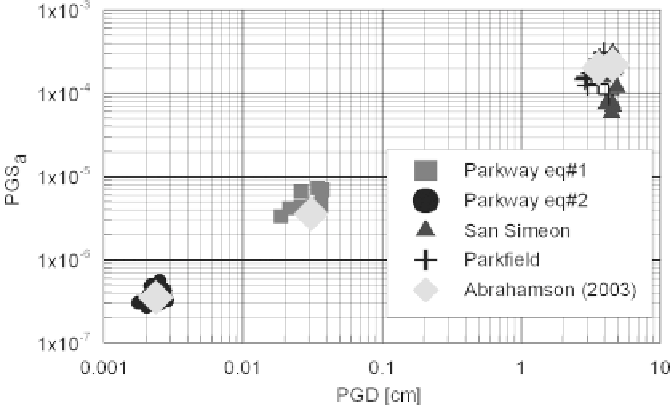Geoscience Reference
In-Depth Information
Indeed, wave passage is only one of the factors affecting the spatial variation of ground
motion,theotheronesbeingcoherencyandsiteeffects.Abrahamson(2003)hasrecently
proposed a model for transient ground strain evaluation, where the relative contributions
of wave passage (
WP
), spatial incoherence (
SI
) and site effects (
SE
) are made explicit
and summed inanempirical relationship between
PGS
and
PGD
:
PGS
/
PGD
=
WP
+
SI
+
SE
(18.4)
10
−
5
,
SE
10
−
5
and
PGD
ismeasuredin
=
(
.
.
)/
=
·
=
·
where
WP
exp
5
8-0
69
M
C
,
SI
3
3
10
5
cm
=
/
=
·
/
centimeters.Considering
C
s,itturnsoutthatthe
SI
contribution
to transient ground strains is more relevant than the
WP
one for
M
2km
s
2
8. It is also
interesting to note that there is a remarkable agreement of eq. (18.4) with the present
data.InFigure18.3,the
PGS-PGD
pairsforthefourdatasetsconsideredarereportedand
compared with the corresponding predictions obtained using eq. (18.4), where
SE
>
5
.
=
0
10
−
5
for Parkway, due to different ground conditions. All
predictions lieclose toground strainsobtained by spatial interpolation.
for the UPSAR and
SE
=
3
·
Although both eqs. (18.3) and (18.4) deserve further investigations and improvements,
they strongly highlight the need to corroborate by experimental observations the current,
probablytoosimplisticandunderconservativeapproachfortransientgroundstraineval-
uation, synthesized by eq. (18.1).
Fig. 18.3.
PGS
-
PGD
pairs for thefour earthquakes listed inTable 18.1. The symbols
correspondingtotheAbrahamson(2003)relationshipareplottedusingtheaverage
PGD
observed for each earthquake and thecorresponding magnitude. From Paolucci and
Smerzini (2007)

